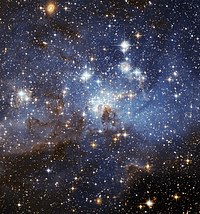
Photo from wikipedia
Context. Comet formation by gravitational instability requires aggregates that trigger the streaming instability and cluster in pebbleclouds. These aggregates form as mixtures of dust and ice from (sub-)micrometre-sized dust and… Click to show full abstract
Context. Comet formation by gravitational instability requires aggregates that trigger the streaming instability and cluster in pebbleclouds. These aggregates form as mixtures of dust and ice from (sub-)micrometre-sized dust and ice grains via coagulation in the solar nebula. Aims. We investigate the growth of aggregates from (sub-)micrometre-sized dust and ice monomer grains. We are interested in the properties of these aggregates: whether they might trigger the streaming instability, how they compare to pebbles found on comets, and what the implications are for comet formation in collapsing pebble-clouds. Methods. We used Monte Carlo simulations to study the growth of aggregates through coagulation locally in the comet-forming region at 30 au. We used a collision model that can accommodate sticking, bouncing, fragmentation, and porosity of dustand icemixed aggregates. We compared our results to measurements of pebbles on comet 67P/Churyumov-Gerasimenko. Results. We find that aggregate growth becomes limited by radial drift towards the Sun for 1 μm sized monomers and by bouncing collisions for 0.1 μm sized monomers before the aggregates reach a Stokes number that would trigger the streaming instability (Stmin). We argue that in a bouncing-dominated system, aggregates can reach Stmin through compression in bouncing collisions if compression is faster than radial drift. In the comet-forming region (∼30 au), aggregates with Stmin have volume-filling factors of ∼10−2 and radii of a few millimetres. These sizes are comparable to the sizes of pebbles found on comet 67P/Churyumov-Gerasimenko. The porosity of the aggregates formed in the solar nebula would imply that comets formed in pebble-clouds with masses equivalent to planetesimals of the order of 100 km in diameter.
Journal Title: Astronomy and Astrophysics
Year Published: 2018
Link to full text (if available)
Share on Social Media: Sign Up to like & get
recommendations!